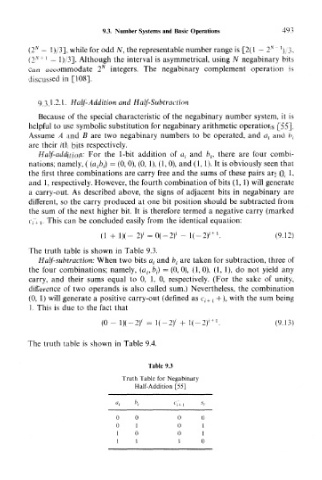Page 508 - Introduction to Information Optics
P. 508
9.3. Number Systems and Basic Operations 49 5
5
N
A
(2 — l)/3], while for odd N, the representable number range is [2(1 — 2 ~ )/3,
(2 N+ l — l)/3]. Although the interval is asymmetrical, using N negabinary bits
N
can accommodate 2 integers. The negabinary complement operation is
discussed in [108].
9.3.1.2.1. Half-Addition and Half-Subtraction
Because of the special characteristic of the negabinary number system, it is
helpful to use symbolic substitution for negabinary arithmetic operations [55].
Assume A and B are two negabinary numbers to be operated, and a { and b t
are their ith bits respectively.
Half-addition: For the 1-bit addition of a, and b {, there are four combi-
nations; namely, ((a t b^ — (0, 0), (0, 1), (1, 0), and (1,1). It is obviously seen that
the first three combinations are carry free and the sums of these pairs are 0, i,
and 1, respectively. However, the fourth combination of bits (1,1) will generate
a carry-out. As described above, the signs of adjacent bits in negabinary are
different, so the carry produced at one bit position should be subtracted from
the sum of the next higher bit. It is therefore termed a negative carry (marked
t'j+j. This can be concluded easily from the identical equation:
;
i+
(1 + 1)(- 2)' = 0(-2) - l(-2) '. (9.12)
The truth table is shown in Table 9.3.
Half-subtraction: When two bits a t and b t are taken for subtraction, three of
the four combinations; namely, (fl £, b f) = (0,0), (1,0), (1, 1), do not yield any
carry, and their sums equal to 0, 1, 0, respectively. (For the sake of unity,
difference of two operands is also called sum.) Nevertheless, the combination
(0, 1) will generate a positive carry-out (defined as c i+1 + ), with the sum being
1. This is due to the fact that
The truth table is shown in Table 9.4.
Table 9.3
Truth Table for Negabinary
Half-Addition [55]
0 0 0 0
0 1 0 i
1 0 0 1
1 1 1 0

